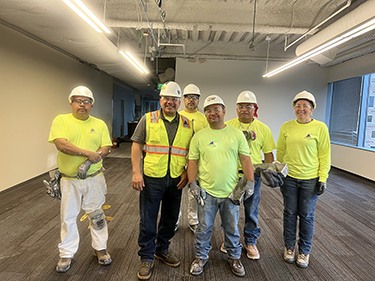|
Subscribe / Renew |
|
|
Contact Us |
|
| ► Subscribe to our Free Weekly Newsletter | |
| home | Welcome, sign in or click here to subscribe. | login |
Construction
| |
 |
October 16, 2023
Helping diverse subcontractors clear more hurdles
Lease Crutcher Lewis

Sorensen
|
Not long after first hearing about his company, I called Jimmy Matta to ask how we might work together someday. At first, I could sense some reluctance on the other end.
As the president and founder of Burien-based Ahora Construction, Jimmy had built a solid reputation for his growing framing and drywall business. But when partnering with large contractors, he told me his experiences have been mixed.
I invited Jimmy to our Seattle office, where we connected within minutes. Getting to know him and his team the past year and a half has helped shed light on some of the roadblocks that may have otherwise deterred Ahora, a minority-owned business, from working with Lewis.
One of the overarching reasons is this: companies like Ahora don’t often get treated like the small businesses that they are.
Together, we took those learnings to develop a program aimed at making a potential collaboration fruitful for all while also opening new opportunities for Ahora beyond Lewis. In turn, our local market could see added building capacity, and we’d help build a more sustainable community of trade partners.
DEVELOPING A PILOT PROGRAM
Hiring disadvantaged businesses is important work, but it’s not as simple as sending out requests for proposals and watching the responses roll in — even on some of the region’s most transformational projects or for the most well-known owners. They don’t always materialize.
When it comes to bidding, Jimmy knows his company will never be the low bid on a project. Ahora’s overhead ratios prevent it, and if a larger company than his really wants that project, it can lower its profit margin to win. Given the constraints, this begs the question of why Ahora or other disadvantaged businesses would even try.
On a typical project, it can take up to seven weeks for a subcontractor’s invoice to get paid. That’s seven weeks of payroll and seven weeks of bills to bridge. Large companies can float that cash. Smaller businesses can’t.
Even if the business clears cash flow and low-bid hurdles, the owners may find themselves more reliant on lines of credit that siphon off even more revenue. This means they can’t make enough money to reinvest and build their business, let alone have anything left over.
Once we better understood the challenges, we set out to design and test a pilot program.
To move past the cash flow issue, we asked a project owner — a preeminent Eastside software company — to put down a deposit. The software company wouldn’t have to pay Ahora up front. Instead, Lewis would release the funds after the scope had been completed to our satisfaction. This would require a deep, trusting relationship between Lewis and our client and between Lewis and Ahora.
Afterward, we took a deep dive into Ahora’s project plans. What is the phasing plan? What is the schedule? Where are the resources coming from? Collaborating on these questions maximizes the value of the subcontractor’s work to both Lewis and our client while ensuring the subcontractor is successful.
Ahora was ultimately matched up to work on a client’s Eastside campus, which entailed two floors of drywall scope. And now, as of this writing, Ahora is working with Lewis on another large technology company’s projects, as well on Lewis’ sustaining work at Fred Hutchinson Cancer Center.
Jimmy and his team have not only proven themselves in the field, but they’ve also built trust and buy-in with key Lewis stakeholders, like the project managers and superintendents working to minimize risk and ensuring our projects are successful.
While building its foundation of work with Lewis and expanding its network, Ahora is molding the template for how it hopes to work with other general contractors in the future, along with the processes, procedures, and systems being refined along the way. Lewis, meanwhile, has gained another trusted partner in our corner.
THE RIGHT OPPORTUNITY
Last year, at an industry event hosted by Microsoft as part of its Crafting Futures Together courses, I met Nathaniel Hartley, longtime owner of Portland’s Professional Lath and Plaster and a 40-year industry veteran.
Nathaniel’s growing company is the only Black union signatory of its kind in the Pacific Northwest and has had a hand in completing a variety of high-profile projects over the years: schools, courthouses, airport terminals, Portland high-rises and more.
We got to talking about our shared love of music — I play the guitar and Nathaniel is an accomplished vocalist — before turning to work. Nathaniel offered the names of minority-owned subs in his network, and several of them have since been hired on Lewis projects.
Recently, we invited Professional Lath and Plaster to partner with us on a technology client’s campus refresh on the Eastside. It would be an opportunity for Nathaniel to expand his business into Washington, where the company had worked previously. After further reflection and discussions with the owner, however, we agreed it would be better to wait for the right project, one with adequate margins and that would not expose our partner to unnecessary risk.
Since then, Nathaniel has sought my advice when he’s had contract questions. I’ve also learned about some of the challenges he’s faced in growing his business, like bonding requirements that presuppose access to capital that many minority-owned companies have historically struggled to access in the first place.
We’ve committed to partnering with Professional Lath and Plaster the next time the right project scope comes around, which Nathaniel can use to move his business forward.
In a broader sense, we’re interested in doing more than simply achieving a percentage goal on our projects. Those goals don’t speak to a business’ health as a company. Instead, we’re working to achieve those goals by making the businesses on our team more successful.
CREATING LASTING IMPACT
Jimmy and I continue to meet every few weeks, whether it’s to talk generally about how our projects are going, or for one-on-one business coaching.
While chatting the other day, Jimmy shared that he recently drove past the Fred Hutch campus and found himself exclaiming “Wow!” It hit him there in the driver’s seat: that Ahora, the company he built, was playing a direct role in a vital institution’s success.
As I look back on my 26 years at Lewis and counting, a variety of big and meaningful projects come to mind. Yet, it’s the time spent getting to know people like Jimmy and Nathaniel, and the experience of supporting the success of their businesses, that have been just as gratifying.
Jay Sorensen is president of Lease Crutcher Lewis’ Washington division.
Other Stories:
- 5 not-so-secret tips for winning work
- Ace Handyman Services franchisee Stanley Sanchez’s journey to success
- ACE Mentor Program builds a path to a fully representative workforce
- Building a culture of inclusion inside and out



